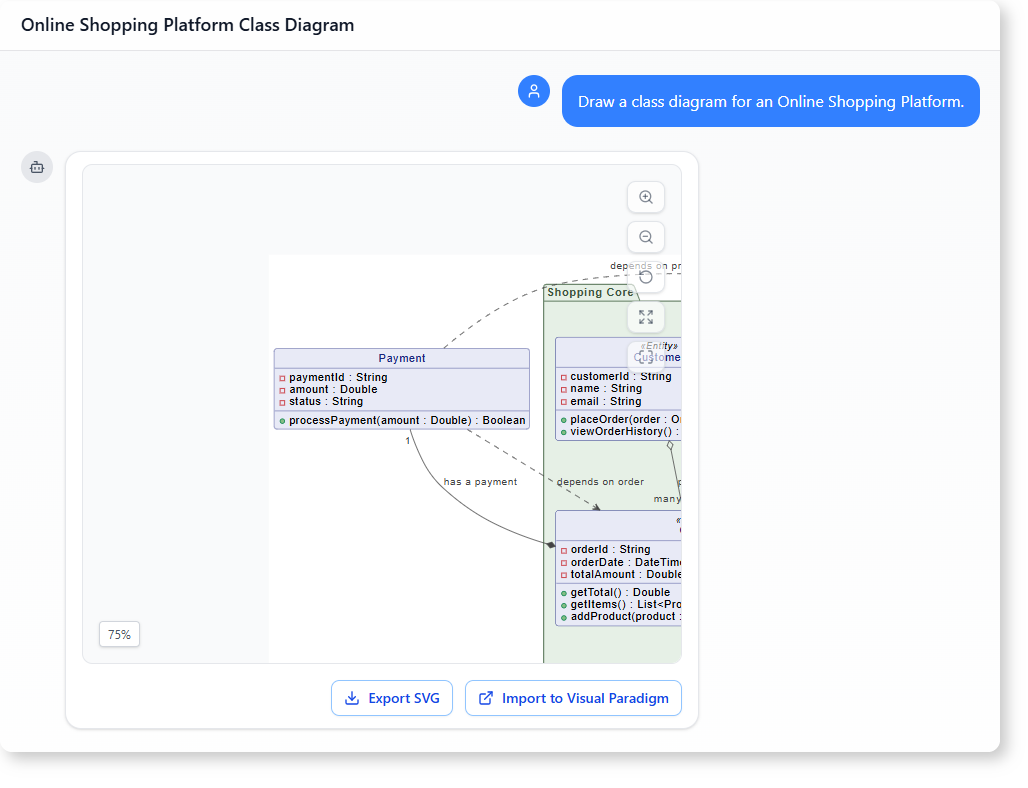Now Reading: How AI-Powered Modeling Software Builds a Smart Online Shopping Platform Class Diagram
-
01
How AI-Powered Modeling Software Builds a Smart Online Shopping Platform Class Diagram
How AI-Powered Modeling Software Builds a Smart Online Shopping Platform Class Diagram
How AI-Powered Modeling Software Builds a Smart Online Shopping Platform Class Diagram
Imagine a startup founder who needs to explain how their online shopping platform works to a technical team. They don’t want to write code. They don’t want to draw boxes and lines from scratch.
Instead, they ask a simple question: “Draw a class diagram for an online shopping platform.”
With AI-powered modeling software, that request turns into a clear, structured visual of the system—complete with classes, relationships, and real-world logic.
This is not just a diagram. It’s a blueprint of how users interact with products, place orders, make payments, and leave reviews. And the whole thing is generated in minutes.

What the User Needed
The user was a product manager at an early-stage e-commerce startup. Their team was expanding and needed a clear model of the system to guide development.
They didn’t have time to manually create a class diagram. They also didn’t want to rely on someone with deep UML experience.
Their goal was simple: understand the key components of an online shopping platform and how they connect—without spending hours on modeling.
The Journey: From Prompt to Diagram
The process began with a single, focused prompt:
“Draw a class diagram for an online shopping platform.”
The AI-Powered Modeling Software interpreted this request and generated a complete class diagram with the following elements:
- Core entities: Product, Order, Customer, Payment, Shipping, and Review.
- Relationships: Associations, compositions, aggregations, and dependencies.
- Logical groupings: The diagram is organized under a ‘Shopping Core’ package for clarity.
After reviewing the initial diagram, the user asked for a deeper breakdown:
“Create a structured report that identifies key classes, associations, and their significance.”
The AI responded with a clear, readable report that explained:
- Which classes represent core business data (like Product and Order).
- How relationships define interactions (e.g., an Order contains items and has a payment).
- Why certain associations matter (e.g., a Product can be reviewed by many users).
This report helped the team understand not just what was in the diagram, but why those connections exist.
What the AI-Powered Modeling Software Delivers
This isn’t just a diagram. It’s a system-level understanding built with real-world logic:
- Product is the center of the platform. It holds details like price and stock.
- Orders represent user actions and contain line items, payment, and shipping.
- Customers place orders and leave reviews, forming a feedback loop.
- Reviews connect products to user experience.
Relationships are meaningful:
- An Order contains multiple OrderItems—this shows how purchases are structured.
- Order has a one-to-one payment and shipping—this defines the completion of a purchase.
- A Customer can place many orders and leave many reviews—this reflects real-world user behavior.
- A Product is reviewed by many users and can be part of multiple orders.
These aren’t abstract links. They reflect how actual users shop.
Why This Matters for AI-Powered Modeling Software
Traditional tools require hours of manual work to produce a class diagram. Even with templates, the process is tedious.
AI-powered modeling software changes that.
It reads natural language prompts and converts them into accurate, well-structured diagrams. No prior UML knowledge is needed.
This means:
- Product managers can now describe their system in plain terms.
- Developers get immediate clarity on how components interact.
- Teams avoid costly misunderstandings from misaligned models.
This is exactly what AI modeling tools do—turn business questions into real system designs.
Comparison: Manual vs. AI-Powered Approach
| Aspect | Manual Process | AI-Powered Modeling |
|——-|—————-|———————-|
| Time to generate | Hours | Minutes |
| Requires UML knowledge | Yes | No |
| Accuracy of relationships | Depends on user input | Based on logical business rules |
| Clarity of structure | Low without templates | High, with clear grouping |
| Real-world relevance | Often missed | Naturally captured |
A Real-World Use Case in Action
The user didn’t just want a diagram. They wanted to understand the system’s flow.
By asking for a report, they gained insight into:
- How a product links to orders and reviews.
- Why payment and shipping are tied to an order.
- How customer behavior drives the platform’s design.
This level of detail helps teams make smarter decisions—whether it’s improving checkout flow or adding product search features.
Frequently Asked Questions
How does AI-powered modeling software understand business needs?
It listens to natural language prompts and interprets them as system components. For example, when a user says ‘online shopping platform,’ the AI identifies key entities like Product, Order, and Customer and builds relationships based on common business patterns.
Can AI generate a class diagram for any system?
Yes. Whether it’s an online shopping platform or a healthcare app, the AI-powered modeling software can generate a class diagram by understanding the context of the prompt and mapping it into standard system components.
What is the difference between a class diagram and a UML class diagram?
A UML class diagram is a formal modeling standard. An AI-powered modeling software creates a UML class diagram—but without requiring users to learn the syntax. It translates plain language into a structured, professional diagram.
Is this tool useful for non-technical people?
Yes. Business owners, product managers, and even customers can describe their system in everyday language. The AI then generates a clear, accurate diagram that technical teams can use.
Ready to map out your system’s interactions? Give our AI-powered modeling software a try at Visual Paradigm’s AI Chatbot today!.
